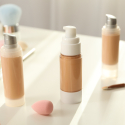Comprehensive Guide to Facial Scrubs: Questions and Answers
 Facial scrubs are an essential part of a well-rounded skincare regimen. By exfoliating the skin, they help remove dead skin cells, promote cell renewal, and leave the complexion looking fresh and radiant. This guide addresses common questions about facial scrubs, providing insights and tips for their effective use.
Facial scrubs are an essential part of a well-rounded skincare regimen. By exfoliating the skin, they help remove dead skin cells, promote cell renewal, and leave the complexion looking fresh and radiant. This guide addresses common questions about facial scrubs, providing insights and tips for their effective use.What is a Facial Scrub?
A facial scrub is a skincare product designed to exfoliate the skin by removing dead skin cells from the surface. It typically contains small, abrasive particles that help slough off these cells, revealing smoother and brighter skin underneath.
Types of Exfoliants
Facial scrubs can contain various types of exfoliating particles, such as:
Natural particles: like crushed nuts, seeds, or sugar.
Synthetic beads: which are often more uniform and less abrasive.
Enzymatic exfoliants: that use natural enzymes to dissolve dead skin cells without physical scrubbing.
Why Use a Facial Scrub?
Regular exfoliation with a facial scrub can offer numerous benefits for your skin.
Benefits of Exfoliation
Improves Skin Texture: Helps in achieving a smoother skin surface by removing rough patches.
Promotes Radiance: Enhances the skin's natural glow by removing dull, dead cells.
Prevents Clogged Pores: Reduces the likelihood of acne and blackheads by keeping pores clear.
Enhances Product Absorption: Allows other skincare products to penetrate more deeply and work more effectively.
How Often Should You Use a Facial Scrub?
The frequency of using a facial scrub depends on your skin type and the product's formulation.
Recommended Frequency
Oily or Acne-Prone Skin: 2-3 times a week to keep pores clear.
Normal or Combination Skin: 1-2 times a week for maintenance.
Dry or Sensitive Skin: Once a week to avoid irritation.
How to Use a Facial Scrub Correctly?
Proper use of a facial scrub ensures maximum benefits without damaging the skin.
Step-by-Step Guide
Cleanse First: Start with a gentle cleanser to remove any makeup or impurities.
Apply the Scrub: Take a small amount of scrub and apply it to damp skin.
Massage Gently: Use circular motions to gently massage the scrub over your face, avoiding the delicate eye area.
Rinse Thoroughly: Use lukewarm water to wash off the scrub completely.
Follow with Skincare: Apply a hydrating moisturizer or serum to replenish your skin.
Can Facial Scrubs Cause Damage?
While facial scrubs are beneficial, improper use can lead to skin issues.
Potential Risks
Over-Exfoliation: Excessive use can strip the skin of natural oils, causing dryness and irritation.
Harsh Particles: Scrubs with large, rough particles can cause micro-tears in the skin.
Sensitive Skin Reactions: Those with sensitive skin may experience redness or breakouts if the scrub is too abrasive.
Choosing the Right Facial Scrub
Selecting a suitable facial scrub for your skin type is crucial for achieving the best results.
Factors to Consider
Skin Type: Choose a gentle scrub for sensitive skin and a more robust formula for oily skin.
Ingredients: Look for natural, soothing ingredients like aloe vera, chamomile, and vitamin E.
Particle Size: Opt for finer particles for a gentler exfoliation, especially if you have sensitive skin.
DIY Facial Scrubs: Are They Safe?
Homemade facial scrubs can be a natural and cost-effective alternative to store-bought products.
Popular DIY Ingredients
Sugar: A common ingredient that offers gentle exfoliation.
Honey: Known for its moisturizing and antibacterial properties.
Oatmeal: A soothing option for sensitive skin.
Conclusion
Incorporating a facial scrub into your skincare routine can significantly improve your skin's appearance and health. By choosing the right product and using it correctly, you can enjoy the benefits of smoother, more radiant skin. Remember to exfoliate in moderation and always follow up with proper skincare to maintain a balanced and healthy complexion.









